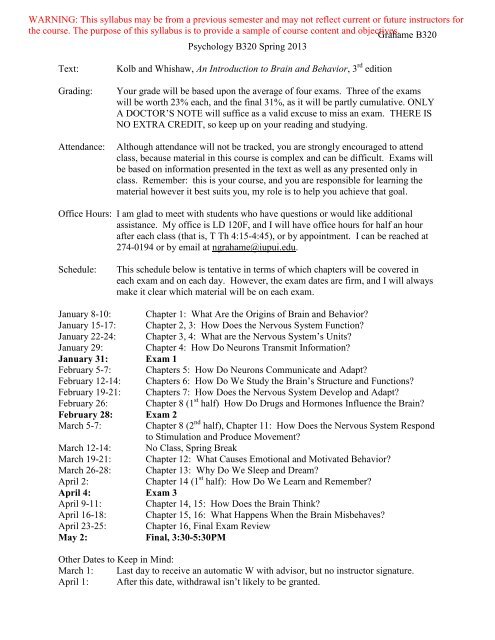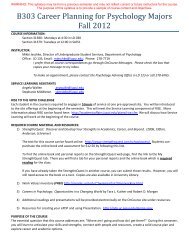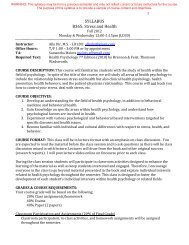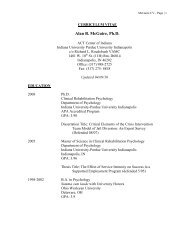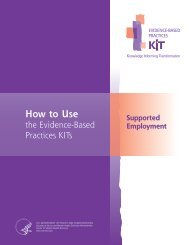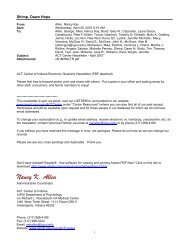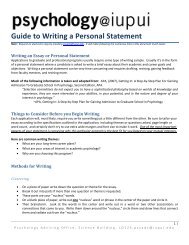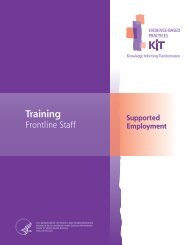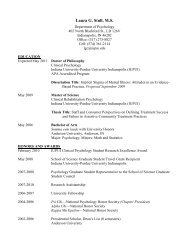January 8: - Psychology @ IUPUI
January 8: - Psychology @ IUPUI
January 8: - Psychology @ IUPUI
You also want an ePaper? Increase the reach of your titles
YUMPU automatically turns print PDFs into web optimized ePapers that Google loves.
WARNING: This syllabus may be from a previous semester and may not reflect current or future instructors forthe course. The purpose of this syllabus is to provide a sample of course content and objectives.Grahame B320<strong>Psychology</strong> B320 Spring 2013Text:Grading:Attendance:Kolb and Whishaw, An Introduction to Brain and Behavior, 3 rd editionYour grade will be based upon the average of four exams. Three of the examswill be worth 23% each, and the final 31%, as it will be partly cumulative. ONLYA DOCTOR’S NOTE will suffice as a valid excuse to miss an exam. THERE ISNO EXTRA CREDIT, so keep up on your reading and studying.Although attendance will not be tracked, you are strongly encouraged to attendclass, because material in this course is complex and can be difficult. Exams willbe based on information presented in the text as well as any presented only inclass. Remember: this is your course, and you are responsible for learning thematerial however it best suits you, my role is to help you achieve that goal.Office Hours: I am glad to meet with students who have questions or would like additionalassistance. My office is LD 120F, and I will have office hours for half an hourafter each class (that is, T Th 4:15-4:45), or by appointment. I can be reached at274-0194 or by email at ngrahame@iupui.edu.Schedule:This schedule below is tentative in terms of which chapters will be covered ineach exam and on each day. However, the exam dates are firm, and I will alwaysmake it clear which material will be on each exam.<strong>January</strong> 8-10: Chapter 1: What Are the Origins of Brain and Behavior?<strong>January</strong> 15-17: Chapter 2, 3: How Does the Nervous System Function?<strong>January</strong> 22-24: Chapter 3, 4: What are the Nervous System’s Units?<strong>January</strong> 29: Chapter 4: How Do Neurons Transmit Information?<strong>January</strong> 31: Exam 1February 5-7: Chapters 5: How Do Neurons Communicate and Adapt?February 12-14: Chapters 6: How Do We Study the Brain’s Structure and Functions?February 19-21: Chapters 7: How Does the Nervous System Develop and Adapt?February 26: Chapter 8 (1 st half) How Do Drugs and Hormones Influence the Brain?February 28: Exam 2March 5-7: Chapter 8 (2 nd half), Chapter 11: How Does the Nervous System Respondto Stimulation and Produce Movement?March 12-14: No Class, Spring BreakMarch 19-21: Chapter 12: What Causes Emotional and Motivated Behavior?March 26-28: Chapter 13: Why Do We Sleep and Dream?April 2:Chapter 14 (1 st half): How Do We Learn and Remember?April 4: Exam 3April 9-11: Chapter 14, 15: How Does the Brain Think?April 16-18: Chapter 15, 16: What Happens When the Brain Misbehaves?April 23-25: Chapter 16, Final Exam ReviewMay 2:Final, 3:30-5:30PMOther Dates to Keep in Mind:March 1: Last day to receive an automatic W with advisor, but no instructor signature.April 1: After this date, withdrawal isn’t likely to be granted.
Grahame B320Overview of the CourseThis class focuses on how behavior emerges from the organ that produces it, the brain. You willlearn about evolution and anatomy of the brain, neurophysiology, how brain networks function,and what happens to behavior when the brain has problems. The textbook, Kolb and Whishaw,keeps a fairly clinical perspective on neuroscience, which I think makes the topic moreinteresting and a bit less intimidating to many students. I will largely follow the text and itsordering of the material, with a few main exceptions: I’ll skip over Chapters 9 and 10, which arecovered in the Sensation and Perception course. However, I’ll go a bit more in depth onalcoholism and drug abuse (Chapter 8), behavioral genetics (throughout), and learning andmemory (Chapter 14).ReadingYou are strongly advised to read the relevant chapters before coming to class, so that you maybetter follow the lectures. Your syllabus provides an approximate reading schedule, withmodifications that I’ll announce when applicable at the beginning of class.Learning the MaterialAt the back of each chapter, you will find two sections that are very helpful: Summary and KeyTerms. Online at the publisher’s website, you will find review questions. In addition to readingthe material and attending class, these online and printed sections will help to prepare you forexams. Remember, some exam questions will be based upon pure vocabulary, so learning keyterms is really important. Also, if you don’t know the vocabulary, the chances of being able tounderstand the concepts greatly decrease. My advise is that as you are reading, when youencounter a term you don’t understand, IMMEDIATELY look it up in the Glossary at the end ofthe book (Section G) so that you don’t miss the concept that the book is trying to explain.My Teaching PhilosophyI believe that you are all adults. You are here in school because you are pursuing your own lifegoals. Therefore, it’s your responsibility to learn the material. Some of you learn a great dealfrom attending class, while others of you do not. This is why attendance isn’t reflected in yourgrade. On the other hand, I will not tolerate your missing an exam unexcused.For my part, I am responsible for helping you learn this material. I hope that you will find meapproachable – during class, don’t be afraid to interrupt me to ask a question or raise an issue. Idon’t promise to know the answers (believe me when I say that!) but I am determined to try.Remember, if you have a question, or something seems unclear, chances are that there are lots ofother students in the class who will silently thank you for asking exactly that question. Iespecially welcome any discussion, as this is sometimes the best way to understand the issuesthat will be presented in this class.ExamsExams will be multiple choice and fill in the blank. You will be tested onVocabularyNeuroanatomyKey conceptsKey experimentsMany of these questions can be covered with multiple choice, but you will also be responsiblefor labeling neuroanatomy and cellular anatomy figures that you see in the text. In other words,you’ll get an exam with a figure from your text, and your job will be to label the structures seenin the figure.


